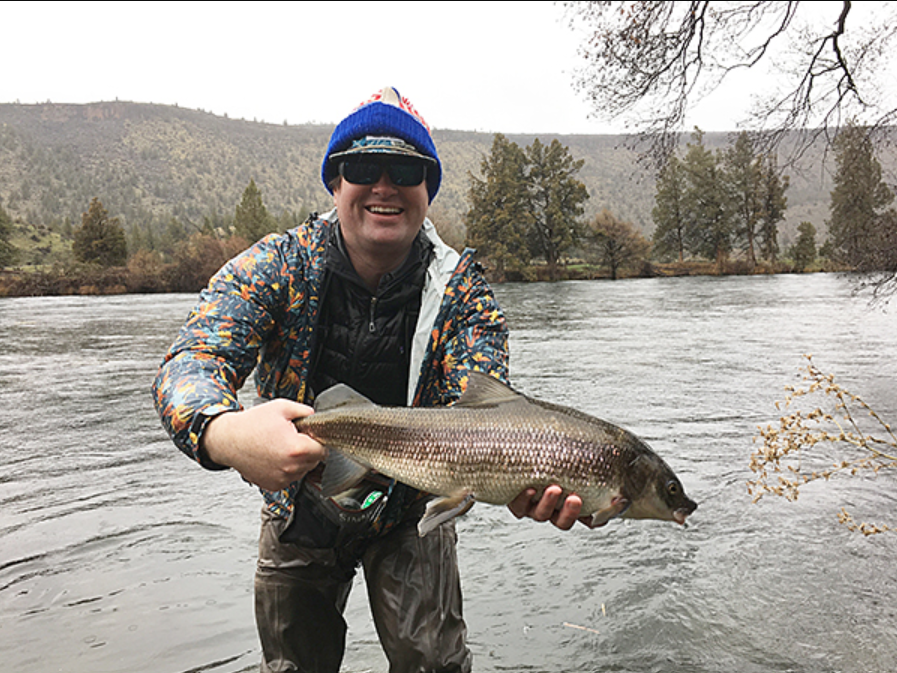Whitefish: This Oregon 'trash' fish is ecologically important and downright delicious

In pursuit of popular game species like rainbow and redband trout, Oregon anglers often hook a less desirable, forgotten species in the process: mountain whitefish.
I’ve heard all the tropes. "Whities" are bottom feeders, sucker fish, even trash fish.
Some of it may be true. They have downward-facing mouths, and they live and feed on or near the bottom. But these native fish are anything but trash. They’re a blast to catch and great indicator that where you’re fishing is the right place to be. They play a crucial role in fragile ecosystems, and they’re also pretty darn good eating.
“In a lot of our rivers, they’re our most abundant fish species,” Oregon Department of Fish and Wildlife biologist Jerry George said. He added that although they’re often forgotten, in systems like the Crooked River, whitefish make up 70 to 80% of the fish abundance.
There are so many, in fact, there is no bag limit on the species in the Beaver State.
While Central Oregon rivers like the Crooked, Deschutes and Metolius have greater densities of whitefish, you won't have trouble finding them closer to the Willamette Valley. I've caught them on the McKenzie and Willamette rivers, and they're plentiful in the Santiam.
The role of whitefish
Whitefish are more sensitive to temperature and water quality changes than many of their salmonid relatives, which make them an ideal indicator for river health. If whitefish are in strong numbers, the river is generally in good shape.
“They are more sensitive to oxygen and temperature than redband trout, so when conditions get stressful, between those two species, they’re the first to show stress and potentially have mortality,” George said.
George said whitefish occupy an important role in the food chain as well.
Whitefish eggs are negatively buoyant and wash into the shallow, rocky-bottom areas where trout feed on them. It’s perfect timing: just as water temperature begins to drop and other food sources begin to decline, a buffet of whitefish eggs allow greedy trout to put on precious calories before the coming winter.
While whitefish and trout species compete for some resources, the success of one does not happen at the expense of the other. There's enough to go around.
“They compete with trout for some of the smaller invertebrates, and some of the larger invertebrates like stoneflies would be more of a trout prey source,” George said.
Year-round, whitefish nosh on midges, worms and other small invertebrates. All these can be cast on a fly rig.
'I just like to see my rod bend'
Often, people catch whitefish by accident. Some do it on purpose.
“I always championed whitefish particularly on the Deschutes,” former ODFW fish biologist Steve Pribyl said. “My default position as a fly fisherman on the Deschutes has always been if I don’t see trout actively rising on the surface, I put on a nymph and go along the bottom. You’re going to catch something, usually a whitefish.”
“I just like to see my rod bend,” he added.
Once you get into a group of whitefish, it’s hard to miss. They’re eager biters, and they make for a fun fight on light gear. You can target them with a 4 or 5-weight rod, with an indicator and small midge or hare’s ear nymph. Beadhead scuds, leeches and egg patterns also do the trick.
“When I was living in Maupin, we would actively target whitefish in the Deschutes,” Pribyl said.
Whitefish attack small nymphs, midges and sinking flies with an intensity similar to smallmouth bass, and often jump when hooked.
These fish have small, circular mouths, which can make for difficult hook-setting. Using small flies will help. Sometimes, especially on faster water, you’ll have trouble getting the nymph or midge to the proper depth where the whitefish will be holding.
Typically, you can solve this by mending your line upriver the second your fly hits the water. This will cause the nymph to sink immediately in front of your indicator, rather than the opposite. When your indicator leads your nymph, it causes drag and pulls your nymph up from your desired drifting depth.
They're abundant and catchable, but are they edible?
Whitefish are tasty
Whitefish meat is firm and similar to trout. They have the same bone structure as trout and most other salmonids. Whitefish do possess small, pin-like bones along their spines, so filleting requires a slightly altered technique to that of other gamefish.
Most prefer whitefish smoked to make lox or a delicious chip dip, but there is room for creativity.
Another popular method for cooking whitefish is to pan-fry it. Once the fish is filleted, begin by seasoning and lightly breading the fish on both sides. Using olive oil or butter on a non-stick pan, cook the fish to perfection in just a few minutes on each side. Squeeze some lemon juice on the filets while cooking to add some zip. Once the fish is firm and flakey, it’s ready to eat.
If you're feeling fancy, whitefish is suitable for upscale table fare. Don't believe me? Check out this whitefish curry recipe at bit.ly/42uv6Ut
You can keep up with regulations and harvesting rules at bit.ly/3LUVLTm
Whitefish may be forgotten, but they're far from trash. This native species is fun to catch, ecologically important and downright delicious.
Charles Gearing is an outdoors journalism intern for the Statesman Journal. He can be reached at cgearing@gannett.com.
This article originally appeared on Salem Statesman Journal: Oregon’s 'trash' fish is ecologically important, downright delicious

